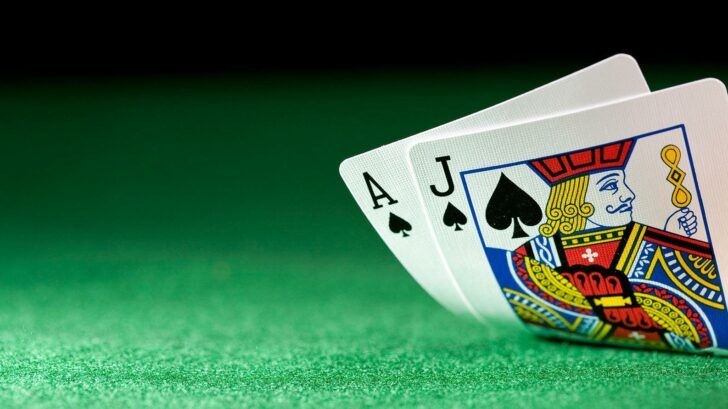How Sticking to Your Blackjack Strategy Card Will See You Through a Stiff Hand

Don’t let being dealt a stiff hand get you down. With a bit of careful study and practice, you’ll have the dealer in the palm of your hand.
The classic casino game of blackjack involves an almost countless amount of variables and tidbits of analysis on smart strategies. While most casino strategy resources look at the big picture and provide lists of tips and tricks, it’s useful to look at aspects of blackjack strategy with an in-depth lens.
Today we take a look at “stiff hands” and the proper way to play them; when to hit, when to stand, and how the dealer’s upcard can inform your betting decision. The stiff hand represents a high-risk situation that can be tricky for a beginning player, but with a little study you’ll have the house’s money flowing into your pocket.
What is a stiff hand?
A stiff hand is one in which the initial two cards amount to between 12 and 16 and don’t contain an ace. They’re called “stiff” because there isn’t much margin for error, a single mistake can cause you to bust. You need to know what you’re doing in order to wind up on top of this sticky situation.
The good news, however, is that correct basic strategy will see you through (as always). Remember that the goal of blackjack isn’t to not bust, it is to beat the dealer. As we learned previously, playing with the intention of avoiding the bust is a bad losing strategy that results in a very high house edge.
You can’t be afraid of hitting with a stiff hand. You just need to know when the odds are in your favor.
The first step is to compare your stiff to the dealer’s hand. While you can’t know for certain what the dealer has (because their “hole card” is face down), properly reading the dealer’s upcard can give you enough information to make a well-informed decision.
Just follow a blackjack strategy card
If the dealer’s upcard is a 2-6, the chance of them having a stiff hand are high. The upcard indicates that their hand is most likely high enough for them to bust, but low enough (less than 17) to require them to hit. Remember that while the player can hit or stand at his own discretion, the dealer is bound to a strict set of rules.
If the dealer has a hand between 2-6 his chances of busting are relatively high, so you should stand and hope that the cookie crumbles in your favor. In this case, hitting means taking on unnecessary risk.
If the dealer has an upcard between 7 and Ace, however, his chance of busting is much lower. For starters, an Ace means he has a soft hand, so the odds of busting are essentially zero.
And with a 7 through King, the dealer probably has a hand of 17 and over, meaning that he’ll be required to stand anyway. The dealer won’t bust, so you need to beat him the old fashioned way. If you have a stiff hand, HIT!
The same rules go double if you’re using a card counting system. For example, when the count is very high you can reasonably expect more ten-value cards to come out of the deck. So if the count is high and the dealer has a 2-6 upcard, you can be almost certain that he has a stiff hand.
Exceptions to the rule
Reading the dealer’s upcard isn’t completely effective, and there are some cases when you should deviate from the simple rule mentioned above: stand when the dealer has a 2-6 upcard, hit when the dealer has a 7-Ace upcard.
For example, if you have a 12 and the dealer has a 2-3, you should go ahead and hit. That’s because the dealer’s chances of busting are not as high as his chances of beating your 12, the weakest stiff hand in the book.
By the numbers
Now we know that if we have a stiff hand, we should usually stand when the dealer has a 2-6 and hit when he has a 7-Ace. Here are some statistics to back up our recommendations. The dealer’s bust rate increases gradually as the upcard increases from 2-6.
2-3 have bust rates under 40% (which is why you should sometimes hit in this situation), while 4-6 are above 40%, with 5 capping things off with a bust rate of almost 43%. On the other hand, the bust rate decreases as the upcard moves upward from 7 to Ace.
The dealer bust rate is 26% with a 7 upcard, gradually declines and finally settles at 11% with an Ace. So while handling a stiff hand might seem complicated, it’s pretty simple if you just memorize the following chart:
| Dealer’s Upcard |
Bust-Out Rate |
| 2 | 35.30% |
| 3 | 37.56% |
| 4 | 40.28% |
| 5 | 42.89% |
| 6 | 42.08% |
| 7 | 25.99% |
| 8 | 23.86% |
| 9 | 23.34% |
| 10 | 21.43% |
| Ace | 11.65% |
What lesson can we learn from all this? The key to winning at blackjack is learning basic strategy. A blackjack strategy card always knows best.




